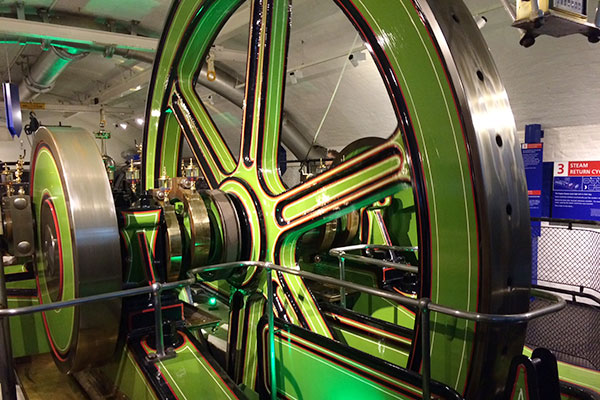On Monday 5th November, the RSA team spent a fascinating day at one of Yorkshire Water’s 83 treatment centres in Headingley, Leeds. Peter Thornes from Yorkshire Water’s education team provided 20 students working on this year’s ‘Valuing Water’ brief with a unique insight into the world of water treatment. Zoe Allis, R,D & I Project Manager at Yorkshire Water and the RSA Student Design Awards team also joined the visit.
The Headingley plant we visited treats enough water to serve 4.7 million people throughout the Leeds and Headingley area, and treats 1.24 billion litres of drinking water per day. To put this into perspective, this is enough water for everyone in the world to have a small cup full of water. Per person in this area, people use on average 153 litres of this high grade drinking water, a shocking 40 litres of that can come from leaving the tap on while you are brushing your teeth (which 10 percent of Yorkshire water drinkers admitted to doing!), 110 litres from a washing machine, and a hose or sprinkler up to 810 litres.
So how does the water get from the source to our taps – and where does it come from? Peter told us how 44 percent of the water treated in Yorkshire is from reservoirs, 33 percent from rivers, and 22 percent from boreholes (these tend to be on higher ground up in the peaks). The remaining 1 percent of water is from ‘tunnel gather’ – sitting water that is collected from the tunnels and pipes
This ‘raw’ water arrives at the plant ready to be treated. It is currently slightly coloured, with a high level of turbidity (tiny particles such as sediment, plankton, or organic by-products) and contains potentially harmful bacteria. This is when the treatment process begins.
The first stage is to remove to negatively charged turbidity by adding positively charged aluminium sulphite to the water – this is known as flocculating. This causes all the particles to clump together to form a brown sludge that, with the help of oxygen being passed through the water, floats to the surface. This sludge is now removed by slowly rotating brushes, which skim the surface of the water and brush the waste into the sewers.
After this, the filtering process begins. Only sand is used to filter the water, rather than the more traditional method of a combination of materials. These filters need to be cleaned daily, which takes one hour.
Once filtered, the water travels outside to the o-zone tank. O-zone is an unstable oxygen molecule, which provides a powerful oxidising agent that is toxic to most waterborne organisms. This kills everything in the water, and it is now ready to drink. However as the water is going to be travelling through the mains, it needs to be chlorinated to ensure its purity in case of leaks. The chlorine stays in the water for 30 minutes to ensure all bacteria have been killed, and that all of the water has the correct level of 1mg/litre of water. Finally the water reaches the underground tank ready to be piped to people’s homes.
Despite all of the processes that are happening 24/7 at the plant, there is usually just one person on site. The whole process is monitored by computer, and can be accessed externally if a problem were to arise.
After this fascinating insight into a process that many of us are oblivious to, and take completely for granted, we chatted to Zoe about the issues that arise when selling water. Water is a human right, and a life necessity, making it very different to selling gas or electricity, which can be cut off. People need water, and water companies are legally obliged to provide it. We are using more and more water, and the treatment centers can only produce a certain amount. Yorkshire Water are desperate to get people to cut down on their water use, but it is extremely difficult for them to monitor water usage.
All of the water that comes into our homes is this top grade drinking water, even if it is just used to feed the plants in the garden. Is this a wasted process if a large amount of water is not consumed? How can we get people to appreciate the quality of the water that they are using?
Water meters can only be installed at a customer’s request, and many feel that they are taking a gamble and will end up paying more than they currently are on a fixed rate. This is very often the opposite of the truth, and meters generally save people a lot of money, as well as allowing and encouraging people to be aware of water consumption. There can be difficulty when installing meters in old properties such as Victorian terraces, where the pipes are often in a tangle!
Leakage is also a big problem for water companies, as a huge amount of water is lost this way. Without a meter in place, it is difficult to find pipe leaks, and the old fashioned method of listening for the gushing of water with a long ear horn is still used.
With the UK’s population predicted to grow by 10 million over the next 20 years, the demand for water will increase. We need to tackle these issues now before we get to this point. How can we use design to communicate and reveal the inherent value of water? From everything we learned at the site visit, we feel that the solution will be holistic and take in behaviour and/or culture change, so that people improve their understanding of water as a limited natural research and commodity.
We can’t wait to see the design solutions that this year’s students submit in March 2013, both for the Valuing Water brief, and all seven others. For any more information on the Yorkshire Water site visit, or any questions relating to the RSA Student Design Awards, please contact Sevra Davis ([email protected]) or Hilary Chittenden ([email protected]). Download the briefs here.
Related articles
-
Blog: Saving Design Thinking from itself
Sevra Davis
We have arrived at a critical moment for design thinking. Sevra Davis explores how we can champion a radical new future for design.
-
36 Hours in Hong Kong
Sevra Davis
Have you ever spent 36 hours in Hong Kong? Sevra Davis has! As the RSA Director of Design and Challenges and Student Design Awards, Sevra was invited to Hong Kong by Birmingham City University in collaboration with the School of Higher and Professional Education (SHAPE) programme at Hong Kong Design Institute (HKDI).
-
Blog: A new day for design for social innovation
Sevra Davis
As the RSA Student Design Awards launch their programme for 2015-16, we look at how design thinking can help create social innovation









Join the discussion
Comments
Please login to post a comment or reply
Don't have an account? Click here to register.
Yorkshire Water is a water supply and treatment utility company servicing east, west, north and south yorkshire. It has origins in the Yorkshire Water Authority, one of ten regional water authorities created by the Water Act 1973, and privatised in 1989.